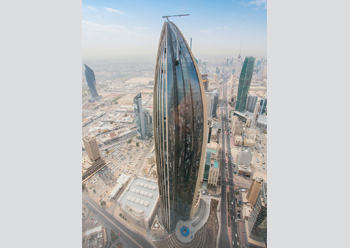.jpg)
.jpg) Oman Botanic Garden will also be home to a visitor centre and educational and research facilities, nestled within the natural ravines and ridges.
Oman Botanic Garden will also be home to a visitor centre and educational and research facilities, nestled within the natural ravines and ridges.
Construction work on the Oman Botanic Garden has reached a major milestone with the lifting of the first structural arch of the northern biome, says its designer Grimshaw, a leading architectural firm based in London, UK.
A total of 43 arches will be used in the construction of the biome, which will be a showcase of the dramatic landscapes of the northern Hajar Mountains, recreating spectacular agricultural terraces and the majestic habitat of ancient juniper trees at the highest altitudes of the mountains.
According to Grimshaw, the arch is made up of seven components that were initially welded on the ground to form three segments, then craned and welded into position. The 26-tonne structure is located at the centre of the building spanning 40 m and reaching a height of 31 m.
 |
|
The most sensitive of Oman’s habitats are enclosed within the two biomes. |
Covering 420 hectares, the Oman Botanic Garden will be the largest of its kind in the Arabian Peninsula and one of the largest in the world. The garden will conserve and celebrate Oman’s botanic diversity within two biomes and surrounding external habitats, containing the country’s most endangered and endemic flora.
Located at the foot of the Al Hajar Mountains, the site itself is one of only a handful of locations in the world where the ancient sea bed is visible, after tectonic activity elevated it to 100 m above sea level. The garden will also be home to a visitor centre and educational and research facilities, nestled within the natural ravines and ridges that traverse the site minimising disturbance to the existing terrain.
“The entire flora of the sultanate can be experienced as visitors make their way through the gardens. The eight defined habitats of the country are sensitively arranged at the centre of the site, bound by Jebel Sufra and the majestic Qurn Mubarak,” says a spokesman for Grimshaw.
“Oman’s wadis, mountains and deserts are represented in an immersive landscape setting, displaying only native species, many of which cannot be found anywhere else in the world. The most sensitive of Oman’s habitats are enclosed within the two biomes, which mimic the species’ natural habitat. The northern biome is a sinuous glass enclosure which re-creates the varied habitats of the northern mountains, including their ancient terraces. The southern biome and its shimmering undulating glass form will enclose the rich and varied habitats found in the Dhofar region, where visitors will be immersed in a moist and green forest ‘Khareef’ setting.
 |
|
A total of 43 arches will be used in the construction of the northern biome. |
Grimshaw has collaborated with Arup, a global advisory, design, planning and engineering company, and Haley Sharpe Design, an international design consultancy in the museum and heritage sector, for the project.
Arup is delivering the engineering, landscaping, architecture and interpretive designs for the Oman Botanic Garden. It has jointly worked with Grimshaw on the existing natural ridges and ravines that traverse the site to design the buildings and walkways, within the spectacular undulating land.
Passive and active shading, ultraviolet (UV) light controls, cooling and plant irrigation are integrated throughout the gardens. Building form, shape and materials have been considered and selected in response to atmospheric conditions and the natural topography.
“Sunlight, weather patterns and human behaviour have informed the garden’s design and ensure the continued preservation of the country’s huge variety of flora,” the spokesman adds.
 |
|
Work is in progress on the 420-hectare Oman Botanic Garden which will be the largest of its kind in the Gulf. INSET: A bird’s eye perspective of the development. |
According to Arup, the buildings, along with the garden site, have been designed to achieve the globally recognised sustainable standard LEED (Leadership in Energy and Environmental Design) Platinum. With water being such a precious resource, particularly in the region, Arup has developed a strategy for the irrigation and water features, with water being sourced sustainably and not wasted.








.jpg)




.jpg)




























.jpg)

































-2.jpg)
